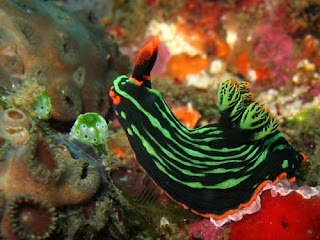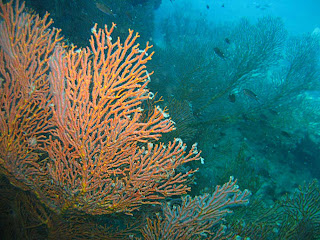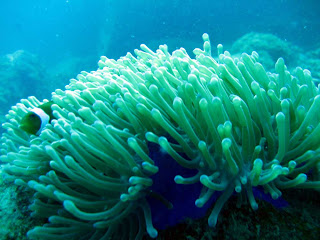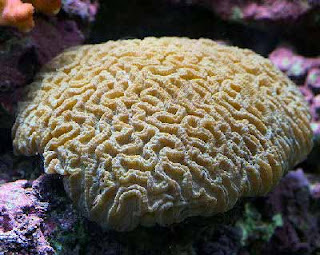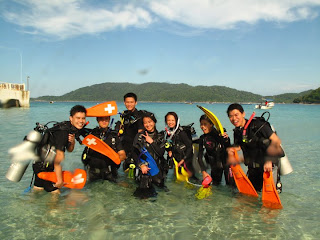Scuba Diving is not just recreactional activity to meet people, do things, go place but help us understanding of the aquatic wonderful underwater world. Accordingly National Geographic there are more than 3000 known nudibranch species, and scientists estimate there are another 3000 yet to be discovered. We as a certified diver we may discover a new species on our driving trip. Probably the most fascinating thing about the nudibranch is the impressive amazing colors. The nudibranchs have the unique shapes, wonderful colors and amazing patterns of mircolife on earth.
Nudibranch is the marine gastropods that constitute the order Nudibranchia (subclass Opisthobranch of the class Gastropoda). Nudibranchs are often casually called "sea slug", but many sea slugs belong to several taxonomic groups which are not related to nudibranchs.Nudibranchs possess a radula feeding organ, but they characteristically lack of shell, gills, and mantle cavity typical of other mollusks.
The delicately colored body has bizarre outgrowths, called cerata, which serve a defensive function, discharging nematocysts that the nudibranch has ingested from cnidarian prey. Cerata also function in gas exchange Antenna-like organs (rhinophores) arise from animal's head.
Nembrotha kubaryana - By Erwin Kodiat
Body black, pustules green and connected into longitudinal lines in some forms; rhinophores and edge of foot bright with orange or red;gills with orange, red or green.
Chromodoris annae - By Sam Ong Beng Hui
Powder-blue, finely speckled with dark spots, and a black band as border, usually with short gap(s) at front and a short black line betwwen rhinophores; edge of mantle white with yellow submarginal band, white gap between black and yellow band distinct and even; gills and rhinophores yellow to orange.
Roboastra gracilis - By Dave Morgan
Body black with yellow to orange lines or instead of lines, numerous dashes forming lines, white to bluish, long gills and rhinophores.
Phyllidia coelestis - By Steven Tessy
Bluish grey with three broad black stripes; tubercles from mostly grey when small to many with yellow tops when large; rhinophroes yellow.
Pteraeolidia ianthina - Dave Harasti
Very long and slender with cerata in fan-like clusters, colour from white (juvenile) to brown, orange and iridescent blue, depending on food source and accumulated zooxanthellae.
Jorunna funebris - By Ronnie Ng
White with irregular dark blotches, usually circular, formes by black tubercles group together, foot with black spot along its margin, rhinophores with tops and gills with black on branches.
Chromodoris coi - By Erwin Kodiat
Mantle large, covering most of its foot;creamish white to pale-pinkish brown with distinctive wavy black-line on upper encircling gills and rhinophores, the inside area slight darker and line offset by white on the outside; gills and rhinophores similar in colour to inside area of upper part.
Discodoris boholiensis - By Mulyadi Setiono
Translucent yellowish white with numerous small brown or white spots and brown blotching, varying to black blotches and white lines around edge of mantle; gills and rhinophores mostly dark brown.
Hypselodoris purpureomaculosa - By Color Chen
White with dark-brown to black blotches, mantle with broad orange to orange-red edge; gills and rhinophores coloured like the mantle edge.
Hypselodoris bullockii - By Sam Ong Beng Hui
Creamy white to deep pink and a thin, distinct white margin on mantle; gills and rhinophores pale yellow to orange.
Asteronotus cespitosus - By Peter Vermeul
Variable from brown to yellow, usually with large broad, lump-like tubercles, often a row or continuous rise over midline of dorsum; gills large, usually reddish; rhinophores as body colour; mantle margin thin and often broadly yellow.
Chelidonura amoena - By Indra Swari
Headshield slug with rounded head, 2 long tail like appendages. Colour is grey-brown, fading at sides, with a fine white punctuation and yellow tips.
Aegires serenae / Also known as Notodoris serenae
Mostly pale bluish grey (rarely yellow) with series of small black pustula many surrounded by a pale ring, and a bright yellow margin on foot; rhinophores bright yellow; gills yellow and black branches, protected by a three very large extrabranchial processes, latter as body colour with pattern of black vein-like lines.
Chromodoris willani - Graham Abbott
Pale blue with black blue-edge stripes and spots, usually a short stripe with spot in front between rhinophores; mantle with white margin; gills and rhinophores peppered with small white sports.
The article is main to supporting diving community as educating materials to learn and understand fantastic mircolife of aquatic underwater for nudibranchs of malaysia dive sites.
Reference: http://www.nudipixel.net/photo/
http://www.dmpm.nre.gov.my
http://www.symbiosis.nre.gov.my/
Sunday, September 18, 2011
Friday, September 16, 2011
Pulau Perhentian Kecil - Long Beach Dive Centers
The Perhentian Islands have two main islands named Pulau Perhentian Kecil and Pulau Perhentian Besar. The white sand is dotted with sun-worshipping holiday island, you can lay on the shade for a glass of freshly squeezed juice enjoy amidst exquisitely cystal clear waters. Scuba divers are boarding a boat to venture out into the turquoise waters and submerge themselves in the underwater wonderland. The Perhentian Islands have some of the best dive site over 20 dive sites suit all level of divers. There are few divers centre along the Pulau Perhentian Kecil - Long Beach as follows:
Quiver Dive Team
Web Address: www.quiver-perhentian.com/Email: Info@quiver-perhentian.com
Address: Long Beach & Coral Bay
Pulau Perhentian Kecil,
22300, Terengganu, Malaysia
Diveshop office tel:- (+6) 012-2138885
Spicy Divers
Web Address: www.spicedivers.net/
Email: Madeleine@spicedivers.net
Musky@spicedivers.net
Address: Spice Divers
Long Beach, Pulau Perhentian Kecil,
22300 Kuala Besut,
Terengganu, Malaysia
Diveshop office tel:- (+6) 09-6911555
(+6) 012-9007510 Madeleine
Panorama Diver
Web Address: http://www.panoramaperhentianisland.com/
Email: panoramadiver@hotmail.com
Address: Panorama Chalet
Kg Pulau Perhentian,
Kuala Besut, 22300
Terengganu, Malaysia
Diveshop Office Tel : (+6) 09-6911598
Matahari Diver
Web Address: www.mataharichalet.com
Email: mataharidivers@gmail.comAddress: Long Beach,
Small Perhentian Island,
22300 Besut Terengganu, Malaysia
Diveshop Tel: (+6) 019-9142883
SunLight Divers | ||
| Web Address: www.sunlightdivers.com/ | ||
Diveshop Tel: (+6) 123071952
Tuesday, September 13, 2011
Monday, September 5, 2011
Top Dives Island at Malaysia
Top Dives at Malaysia
Peninsular Malaysia - West Malaysia
1) Pulau Perhentian
2) Pulau Lang Tengah
3) Pulau Redang
4) Pulau Kapas
5) Pulau Tenggol
6) Pulau Tioman
7) Pulau Aur
8) Pulau Payar
9) Pulau Pangkor
The islands of East Cosast Malaysia are reasonably well conservative, protected and are diveable all year round. However, water visibility is better during the months of April to September
Malaysian Borneo - East Malaysia
1) Pulau Sipadan
2) Pulau Mabul and Kapalai
3) Pulau Lankayan
4) Layang Layang
5) Tunku Abdul Rahman Park Islands
6) Pulau Labuan
7) Pulau Talang-Talang
Peninsular Malaysia - West Malaysia
1) Pulau Perhentian
2) Pulau Lang Tengah
3) Pulau Redang
4) Pulau Kapas
5) Pulau Tenggol
6) Pulau Tioman
7) Pulau Aur
8) Pulau Payar
9) Pulau Pangkor
Advisable Dive Time: West coast Peninsular Malaysia
December - May
December - May
Advisable Dive Time: East coast Peninsular Malaysia
March - October
March - October
The islands of East Cosast Malaysia are reasonably well conservative, protected and are diveable all year round. However, water visibility is better during the months of April to September
Malaysian Borneo - East Malaysia
1) Pulau Sipadan
2) Pulau Mabul and Kapalai
3) Pulau Lankayan
4) Layang Layang
5) Tunku Abdul Rahman Park Islands
6) Pulau Labuan
7) Pulau Talang-Talang
Dive Organization
1) PADI - Professional Association of Diving Instructor
Home Page : www.padi.com/

2) NAUI - National Association of Underwater Instructors
Home Page : www.naui.org/

3) SSI - Scuba Schools International
Home Page : www.divessi.com/

4) BSAC - British Sub Aqua
Home Page: www.divessi.com/

5) CMAS - Confédération Mondiale des Activités Subaquatiques - World Underwater Federation.
Home Pages - www.cmas.org/
Home Page : www.padi.com/

Home Page : www.naui.org/

3) SSI - Scuba Schools International
Home Page : www.divessi.com/

4) BSAC - British Sub Aqua
Home Page: www.divessi.com/

5) CMAS - Confédération Mondiale des Activités Subaquatiques - World Underwater Federation.
Home Pages - www.cmas.org/
Saturday, September 3, 2011
Further fun you can go after you are License Diver
a) Digital Underwater Photographer
b) AWARE - Fish Identification
c) Encriched Air Diver
d) Underwater Naturalist
e) Underwater Navigator
f) Underwater Photographer
g) Underwater Videographer
h) Deep Diver
i) Wreck Diver
j) and more and more
Picture: http:www.padi.com
Wednesday, August 31, 2011
WHY!!!
Why continuing the diver education beyong Open Water Diver?
a) Meet People - From different background, all experience level, different country and etc.
2) Go places - Seaside Beach, Beautiful Sight Scene......
4) Beach Boys and Grils
a) Meet People - From different background, all experience level, different country and etc.
2) Go places - Seaside Beach, Beautiful Sight Scene......
3) Do things - Underwater sightseeing, underwater photography, diving, beach activity, food
4) Beach Boys and Grils
Tuesday, August 30, 2011
Simple 5 Steps
Step 1: Find a Qualified Instructer (Eg: Qualified PADI Instructor)
Step 2: Confined Water Dives
Step 3: Knowledge Development
Step 3: Knowledge Development
Step 4: Open Water Dives
Step 5: Register as Qualified Open Water Diver
Please surf for More Details: http://www.padi.com/ or others dive organization
Subscribe to:
Posts (Atom)
